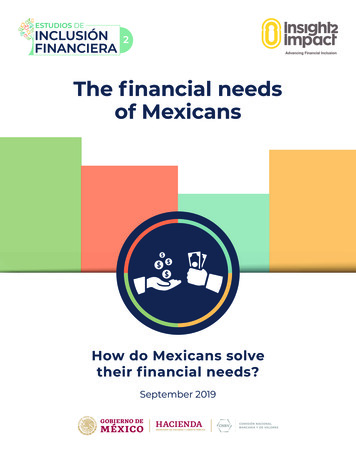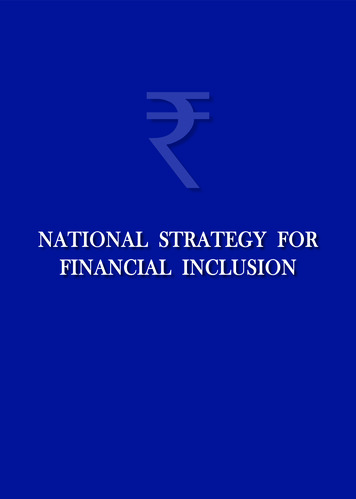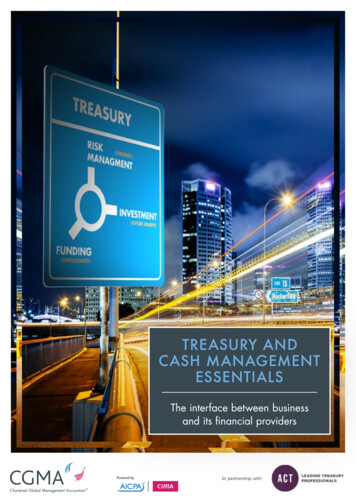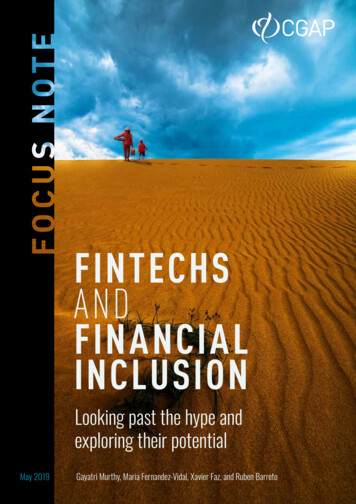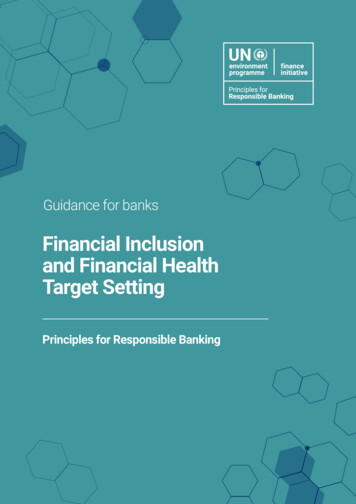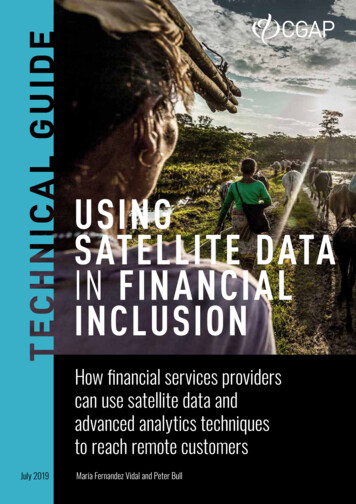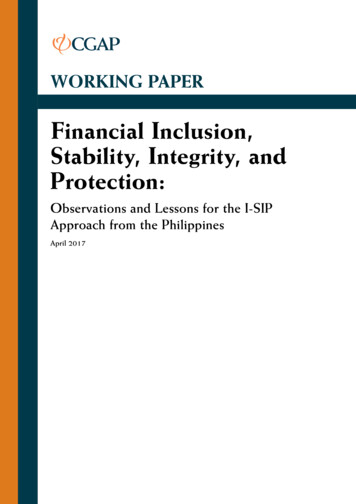
Transcription
National Financial Inclusion StrategyPakistanA strategy for building a dynamic and inclusive financial sector to support Pakistan’sgrowth in the 21st century.
2
Table of ContentsList of Tables and Figures. iiList of Acronyms . iiiExecutive Summary . v1Introduction . 12Current Landscape of Financial Services . 22.12.22.32.42.52.62.83Framework for Action and Headline Targets . 143.13.23.33.43.54Branchless Banking, Payments and Digital Transaction Services. 2Housing Finance . 4Insurance . 6Pensions . 7MSME Finance . 8Agricultural Finance . 10Islamic Finance . 11Framework for Action. 14Key Enablers . 15Drivers for financial inclusion in Pakistan. 17Development and support for an ecosystem of diverse products . 20Headline financial inclusion targets . 20Coordination Structure . 224.14.24.34.4NFIS Council . 22NFIS Steering Committee . 23NFIS Secretariat . 24Technical Committees . 245Key Recommendations and Priority Actions . 266Monitoring & Evaluation Framework . 30Annex 1:Action Plan. 32Annex 2:Financial inclusion among individuals: Banked vs. Unbanked . 38Annex 3:Methodology and Consultative Process . 43i
List of Tables and FiguresTable 1: Evolution of residential mortgage (loans outstanding in PKR billion) . 5Table 2: Insurance penetration (premium as % of GDP) . 6Table 3: Insurance density (premium per capita in USD) . 6Table 4: Understanding of Islamic Banking Model and Products: Banked. 13Table 5: Understanding of Islamic Banking Model and Products: Non-banked . 13Table 6: Proportion of adults (age 15 ) with an account in a formal financial institution . 38Figure 1: Volume and value of mobile money transactions Q1 2013 – Q2 2014 . 2Figure 2: Volume and value of mobile money transactions and agent liquidity . 3Figure 3: NPLs of housing loans . 5Figure 4: Concentration of SME bank lending in working capital loans . 8Figure 5: Total assets, deposits and branches of Islamic banking . 11Figure 6: Interest in Islamic products . 12Figure 7: Framework for Action . 14Figure 8: Proposed Governance Structure for the NFIS . 25Figure 9: Account at formal financial institution by income quintiles . 38Figure 10: Characteristics of Individuals with Accounts in a Formal Institution . 39Figure 11: Individuals who received a loan in the past year (% age 15 ) . 39Figure 12: Trust in Financial Institutions. 40Figure 13: Commercial bank branches and ATMs per 100,000 adults . 41Figure 14: Access points by transaction channels . 41Figure 15: Minimum amount to open checking account and consumer loan fees (% GDP pc) . 42ii
List of VPSAlliance for Financial InclusionBusiness to GovernmentBenazir Income Support ProgramBetter Than Cash AllianceCompound Annual Growth RateCustomer Due DiligenceCitizens National Identity CardDigital Transactional AccountEconomist Intelligent UnitEmployee’s Old-Age BenefitGovernment to BusinessGovernment to PersonGovernment of PakistanHouse Building Finance Company LimitedInformation and Communication TechnologyInclusion, Stability, Integrity and ProtectionIdentification DocumentKnow-Your-CustomerMicrofinance BankMicrofinance InstitutionMobile Network OperatorMinistry of FinanceMicro, Small and Medium EnterpriseNational Database and Registration AuthorityNonbank Finance CorporationNational Financial Inclusion StrategyNational Institutional Facilitation TechnologiesNon-Performing LoanNational Payment SystemOver-The-CounterPakistan Poverty Alleviation FundPakistan Real Time Interbank Settlement MechanismPayment Service ProviderPayment Service OperatorRural Support ProgramReal-Time Online BranchState Bank of PakistanSecurities and Exchange Commission of PakistanSubscriber Identity ModuleSmall and Medium EnterpriseUnstructured Supplementary Services DataVoluntary Pension Schemeiii
Executive Summary1.Since the early 1990’s, Pakistan’s financial sector has undergone considerable reforms thathave significantly strengthened its soundness, profitability, efficiency and diversity. Until thattime, it had been dominated by a handful of nationalized banks that suffered from poorperformance and asset quality. By December 2013, the sector was comprised of 38 commercialbanks; 10 regulated Microfinance Banks (MFBs); a number of unregulated microfinanceinstitutions (MFIs); 46 nonbank finance corporations (NBFCs); 50 insurance companies ofwhich, 40 non-life insurers, 9 life insurers and 1 non-life reinsurer; and 3 stock exchanges. Banksand MFBs are also involved in branchless banking in partnership with mobile network operators(MNOs). The banking sector, now 85% privately-owned, dominates financial services,representing approximately 90% of total financial sector assets. The banking sector is generallysound (Capital Adequacy Ratio of 15.1%) and profitable (after-tax return on assets and equity of1.4% and 15.4% respectively, as of June 2014).2.Pakistan has been a pioneer in championing financial inclusion for over a decade under thecommitted leadership of State Bank of Pakistan (SBP). There have been a large number ofsignificant milestones which include: the creation of a regulatory framework for MFBs (2001);the expansion and modernization of the online credit information bureau (e-CIB, 2005); a seriesof measures to strengthen the safety and efficiency of payments, including the establishment ofthe Pakistan Interbank Settlement System (PRISM) (2008) and the development of interoperable inter-bank card payments platforms; the adoption of Branchless Banking Regulations(2008, amended in 2011); the adoption of a tiered approach to know-your-customer (KYC)requirements; the establishment of a specialized microfinance credit information bureau (m-CIB,2009-2012); the launch of a nationwide Financial Literacy Program (2012); and work on anInclusion, Stability, Integrity, and Protection (I-SIP) methodology (2014). SBP and theGovernment of Pakistan (GoP) have also sponsored a number of guarantee facilities andsubsidized lending schemes aimed at encouraging lending to the underserved. Pakistan’s effortshave been recognized internationally. In 2011 and 2012 its microfinance regulations were rankedbest in the world by the Global Microscope report, and Pakistan was ranked in the top-teninternationally for its enabling environment for financial inclusion in the most recent GlobalMicroscope 2014.3.Despite these sustained efforts, the level of financial inclusion remains very low. Just10.3% of Pakistani adults have an account with a formal financial institution1, well below boththe South Asian average of 33% and the average for all lower-middle-income countries of41.4%2. Fifty-six percent of adults use neither formal nor informal products, and while 36% ofadults save, only 4% save with a formal financial institution.3 Similarly, while one-third of adultsborrow money, only 3% borrow from a formal financial institution. The use of mobile money is1Financial Inclusion Insights, 2014.Findex, 2011. Pakistan is categorized by the World Bank Group as a lower-middle-income country, i.e. one whose per capitagross national income falls between USD 1045 and USD 4125.3Financial Inclusion Insights, 2014. This excludes National Savings, which provides savings to approximately 7.7 millionPakistanis.2v
growing rapidly, but is still limited to 11% of males and 3% of females4. Insurance coverage isestimated at 7%, and only an estimated 7% of adults have a formal pension. The financiallyincluded are overwhelmingly male (86%) and predominantly urban (68%). (See Annex 2 forfurther details regarding financial inclusion of the adult population in Pakistan).4.After years of steady growth, credit to the private sector has declined in real terms over thepast five years. While the total assets and deposits of Pakistan’s banking sector have doubledsince 2008, private sector credit to GDP has declined from 22% in 2009 to just 14.7% in June2014. The decline in credit provided to SMEs has been particularly pronounced, falling from16% of bank lending in 2008 to just 7% in June 2014. The agriculture sector, which represents21% of GDP and 60% of total employment, accounted for just 6% of total lending. The figureson housing finance are even starker. Of a total population of 180 million people, there are only76,0005 housing loans outstanding in the banking sector. Against a backdrop of slow economicgrowth and rising government borrowing, banks have invested heavily in government securitieswhich now amount to 122% of total bank credit to the private sector. Private businesses receivejust 40% of bank credit, and this supply is skewed towards larger enterprises with around 0.4%of bank borrowers accounting for 65% of all bank loans6.5.The low level of financial inclusion and the decline in credit to the private sector can beattributed in part to factors which go beyond the scope of financial sector policy and should beaddressed in the broader economic, social and political context. These include the following: The economic cycle: The decline in credit to the private sector is due in part tocyclical factors. Credit, including to underserved segments such as SMEs andhousing, had been growing rapidly prior to the economic downturn in 2008 whichwas followed by the lowest average five-year period of GDP growth (2.8%) in thepast 60 years. The economic downturn resulted in a decline in demand for credit. Theeconomy is now showing signs of improvement, with growth estimated at 4.3% for2013/14, and private sector credit growth has started to show signs of recovery inrecent months. Business climate: The challenging economic and business climate, including severeenergy shortages and security concerns, has been highly disruptive for businesses,particularly MSMEs, negatively impacting their creditworthiness. There was a sharpdeterioration in asset quality post-2008, particularly in the SME and housing sectors,where NPLs now stand at 34% and 29%, respectively. This has understandablydampened banks’ risk appetite and resulted in a “flight to quality”. Rapidly rising government debt: Public sector debt has risen rapidly, with the fiscaldeficit rising from under 3% of GDP in 2005 to 8.5% of GDP in 2012/13. Over thesame period, private credit declined as a share of banks’ total lending from 75% to45%. Banks’ deposit base has continued to grow during this period, but this growthhas largely been deployed to a rapid expansion of holdings of government securities,which provides banks with a relatively attractive yield at low risk.4Financial Inclusion Insights, 2014.SBP Quarterly Housing Finance Review, 1st Q 2014.6Pakistan 10-Year Strategy Paper for the Banking Sector.5vi
Gender barriers: Women are largely excluded from the formal financial system. Only2.9% of adult females have an account with a formal institution, compared to 17% ofmales. 7 Mobility and social interaction limitations can restrict women’s access tofinancial services. These may be partially addressed by the rapid expansion of digitalfinancial services. However, there is a 42% gender gap in mobile phone ownershipand 30% of females do not even have access to somebody else’s mobile phones8. Aswomen comprise half of the adult population, Pakistan will not be able to achieve aninclusive financial sector unless financial services become truly accessible to all. Itwill require a concerted and creative effort from both government and the privatesector to address ingrained cultural and social barriers that prevent women fromparticipating in the financial sector, and to investigate further the causes of, andpotential solutions to, exclusion.9 Growing informality in the economy: Recent research 10 estimates the size of theinformal economy to be 75-91% of the size of the formal economy -much larger thanpreviously estimated. The informal sector appears to be expanding while the formaleconomy is in retreat. Since banks and other formal financial institutions are reluctantto do business with informal firms, growing informality has contributed to financialexclusion.6.Other reasons for the low level of financial inclusion are varied, and differ from onemarket segment to another as outlined in section 5. However, there is a broad consensus amongstakeholders on several cross-cutting financial sector issues, notably: While SBP has been very proactive in promoting an inclusive financial sector, manyof the issues that need to be addressed fall outside of its regulatory mandate. Forexample, a number of longstanding problems cannot be solved without legislativechanges, but important draft bills, including those on secured transactions, depositinsurance, insolvency and credit bureaus, have been in an uncertain legislativeprocess for years. Progress towards a more inclusive financial system has also beenslowed because of limited commitment and weak coordination between severalgovernment and private sector stakeholders. Weaknesses in the basic financial sector infrastructure and the legal and judicialframework discourage lending, particularly to those perceived as riskier borrowers.The supply of credit to underserved markets is further depressed by: poor contractenforcement, serious deficiencies in land titling and registration, the absence of asecured transactions framework and electronic collateral registry for moveablecollateral and the inability to enforce collateral outside of the slow and unpredictablejudicial system.7Findex 2011World Bank: The Little Data Book on Financial Inclusion.Financial Inclusion Insights 2014.9For example, 9 out of 10 households have access to a mobile phone, but in about one-third of instances, female householdmembers are excluded from such household-level access.10Ali Kemel and Waqas Qasim, Pakistan Institute of Development Economics, 2012.8vii
Lack of capacity in both financial institutions and clients is also a constraint to greaterfinancial inclusion. Most financial institutions have focused on the upper end of thebusiness and retail markets and have not developed the skills, techniques andproducts required to serve other market segments profitably. Microfinance providershave developed this knowledge for microfinance clients, but there is a large “missingmiddle” which is currently not being served. On the client side, a basic lack offinancial literacy and awareness serves to limit demand for financial products andservices.7.The persistence of financial exclusion in the face of long-standing efforts to promoteinclusion points to the need to develop a comprehensive National Financial Inclusion Strategy(NFIS). The strategy comes at a particularly opportune moment as new technology and the rapidexpansion of branchless banking offer unprecedented opportunities to transform financialinclusion in Pakistan. The NFIS provides a vision that underlies the NFIS, a framework and aroad map for priority actions aimed at addressing constraints and significantly increasing accessto, and usage of, quality financial services. The strategy will guide efforts to promote financialinclusion over the coming five years (2015-2020). It includes targets and objectives that will bemonitored, but it is intended to be a living document that can be adjusted as required.8.The NFIS has been agreed to at the national level following extensive consultations withstakeholders. 11 It is being championed by SBP, with shared leadership from the Ministry ofFinance (MoF) and the Securities and Exchange Commission of Pakistan (SECP). Theobjectives are fully consistent with the Government of Pakistan’s Vision 2025, which calls forenhancing access to credit for SMEs and focusing on financial inclusion and deepening.Successful implementation will require the commitment and active engagement of keystakeholders from both the public and private sectors.9.The stated vision for financial inclusion in Pakistan is that: “individuals and firms canaccess and use a range of quality payments, savings, credit and insurance services which meettheir needs with dignity and fairness”. A set of cross cutting conditions – the key enablers – willneed to be put in place as they will lay the foundation for implementing this vision. The keyenablers cut across all priority sectors and are: (1) public and private sector commitment to theNFIS and coordination; (2) enabling legal and regulatory environment; (3) adequate supervisoryand judicial capacity; and (4) financial, payments and information and communicationstechnology (ICT) infrastructure. The key enablers will support targeted actions – the drivers –aimed at increasing access and developing an ecosystem of financial services that will have thequality and features required by the Pakistani population and enterprises. These drivers are: (i)promoting DTAs and reaching scale through bulk payments; (ii) expanding and diversifyingaccess points; (iii) improving capacity of financial service providers; and (iv) increasing levels offinancial capability.10. The current network to distribute financial services in Pakistan falls short, particularly inrural areas, and it does not permit all firms and individuals, especially women, to have easy andconvenient access to even basic accounts. Hence, the NFIS prioritizes the need to increase anddiversify financial service access points such as bank branches, bank agents, ATMs, POS,mobile money agents and remote access through mobile phones and the internet.11Annex 3 provides further details on methodology and consultative process.viii
11. The vision aspires to having universal access to formal accounts, not be limited to simplytraditional savings and checking accounts but would also include digital transactional accounts(DTAs) such as branchless banking accounts. Universal access to formal accounts depends on abalanced KYC regime, improvements in the national payment system (NPS), and on shiftinglarge payment streams from cash to digital platforms. These large payment streams includewages in the public and private sectors, government-to-business (G2B) payments, social cashtransfers, other government-to-person (G2P) payment streams such as pensions, and also P2G(person to government) payments such as fees and taxes.12. Aspiring to a large increase in the number of adults with accounts is a necessary butinsufficient condition to meet the objectives of the NFIS. Individuals and firms must also havethe convenience, tools and confidence to use a range of quality services through these accounts,including simple payments, remittances, savings, credit and insurance products. These servicesshould be provided in both conventional and Islamic-compliant structures. The NFIS calls for thedevelopment of a varied set of financial services that meet the needs of consumers and respectstheir right to dignity and fairness, with a special focus on historically marginalized segmentssuch as low-income households (e.g., small farmers), women, and micro- and small-enterprises.This will require coordinated and parallel efforts with the goals of: Diversifying the range of basic payments, remittance and savings products offered tothe Pakistani population and enterprises through DTAs and bank accounts; Increasing the financing opportunities for urban and rural micro-, small- and mediumenterprises, including agricultural finance for men and women small farmers; Increasing penetration of insurance services; Bringing pensions to more workers, including those in the informal sector; Developing housing finance products, including for low-income segments; Fostering Islamic finance to serve those who prefer Islamic products or who areexcluded or underserved due to their religious beliefs; and Ensuring consumer protection and increasing financial awareness and literacy, as twofoundational pillars for responsible inclusion.ix
x
1 Introduction13. Over half of the world's adult population, or 2.5 billion people, lacks access to formalfinancial services, with the overwhelming majority of the unbanked (90%) living in developingcountries. Greater financial inclusion can bring these people into the financial mainstream, withpositive effects on economic growth, financial stability and social cohesion. Both theoretical andempirical studies 12 have shown that financial exclusion inhibits human and physical capitalaccumulation, contributing to persistent income inequality and poverty.14. Given the positive welfare effects of increased access to finance, building inclusivefinancial systems has become an important objective for policymakers around the world. In2010, the G-2013 produced a set of recommendations known as “The Principles for InnovativeFinancial Inclusion”. The following year, the Alliance for Financial Inclusion (AFI), a globalnetwork of concerned policymakers and supervisors, developed the “Maya Declaration”, the firstset of global and measurable commitments to financial inclusion. The declaration, which hasbeen endorsed by over 80 countries—including Pakistan, commits to: Create an enabling environment that increases access and lowers costs of financialservices, including through new technology; Implement a proportionate regulatory framework that balances financial inclusion,integrity and stability; Integrate consumer protection and empowerment as a pillar of financial inclusion; and Use data to inform policies and track results.15. A number of recent developments have contributed to the timeliness of making a push forfinancial inclusion, including: i) technological innovation such as mobile financial services; ii) amore open regulatory approach to financial inclusion; iii) a greater understanding of some keyingredients of success; and iv) a recognition that market forces alone will not solve the problemof persistent financial exclusion. Developing countries have been on the forefront of pursuinginnovative solutions to tackle the problem of financial exclusion so global initiatives rely heavilyon peer-to-peer learning and knowledge sharing among developing countries.12See, inter-alia, Khandker, 2005, Karlan and Zinman, 2010, Banarjee et al, 2009, and Beck Levine and Levkov, 2010.The Group of 20 (G-20) is a forum for the governments and central bank governors from 20 major economies, accounting for85% of gross world product.131
2 Current Landscape of Financial Services16. The NFIS includes a series of Technical Notes that provide detailed analyses of varioussegments of the financial sector which are important to achieving the strategy’s objectives. TheNotes also include detailed action plans for improving financial inclusion in these marketsegments, the key elements of which are outlined in section 6 and Annex 1 (Action Plan). TheNotes form an integral part of the strategy and will serve as a reference for the TechnicalCommittees charged with coordinating implementation of the strategy in these focus areas. Thissection provides a brief overview of the current state of financial inclusion in these priority areasand summarizes the key constraints to achieving financial inclusion outlined in the Notes.2.1 Branchless Banking14, Payments and Digital Transaction Services17. Pakistan is one of the fastest growing markets for branchless banking in the world. Thecatalyst for this growth was the introduction of the Branchless Banking Regulation in 2008,which allowed banks and MFBs to leverage mobile phone communications and distributionnetworks to bring financial services closer to customers. In addition, SBP has made proactiveregulatory decisions since 2008 which have facilitated a range of sustainable branchless bankingbusiness models. The mobile network is well developed, and while access is not always presentfor all household members, 9 out of 10 households do have access to a mobile phone and SIMcard.1518. Figure 1 below depicts the steady growth in the value and volume of branchless bankingtransactions in Pakistan in the 18 months prior to Q2 2014.Figure 1: Volume and value of mobile money transactions Q1 2013 – Q2 2014Source: Quarterly Branchless Banking Newsletter, State Bank of Pakistan, Apr-Jun 201419. While there are 120 million SIM card holders in Pakistan, only 7% of Pakistani adults hadused mobile money either through their own or others’ accounts. Just 0.4% of adults had14In Pakistan this term means provision of transaction services to a specific class of accounts called as “branchless bankingaccounts”, operated entirely through electronic funds transfers at various alternative delivery channels like agents, ATMs andPOS terminals.15Global Financial Inclusion (Global Findex) Database.2
registered mobile money accounts. The top three reasons survey respondents gave for usingmobile financial services to deliver or receive remittances were: ease of use (more than 60%),safety (25%) and speed (10%).1620. OTC transactions 17 currently represent 80% of all transactions versus only 14% oftransactions are direct wallet-to-wallet (account-to-account). However, wallet-to-wallettransactions are growing in both volume and value thanks to increasing use of e-wallets formobile top ups and bulk payments. The main driver for growth in value has been bulk payments(e.g. government to person, G2P) and cash deposits or withdrawals. Growth in volume can belargely attributed to mobile top-ups, which accounted for a 40% growth in the number oftransactions in Q1 2014.21. The SBP recently issued rules for Payment Services Providers (PSP) and Payment SystemsOperators (PSO). These entities will now be subject to the full supervision and oversight of theSBP and will be prohibited from handling customer or participant funds or conducting anybanking activity. This new development has the potential to stimulate the development of thepayments market. The lack of a clear and detailed regulatory framework for payment systemsand services had prevented the entry of new payment systems and payment services such as:electronic payment gateways for ecommerce transactions; development of systems that wouldenable a higher level of inter-operability for branchless banking services; Third Party ServiceProviders (TPSPs) for providing prepaid card and mobile money solutions; white label ATM andPOS operators and agent networks; and the introduction of inter-bank direct-debit products.Figure 2: Volume and value of mobile money transactions and agent liquiditySource: Quart
borrow money, only 3% borrow from a formal financial institution. The use of mobile money is 1 Financial Inclusion Insights, 2014. 2 Findex, 2011. Pakistan is categorized by the World Bank Group as a lower -middle income country, i.e. one whose per capita gross national income falls between USD 1045 and USD 4125. 3 Financial Inclusion Insights .
